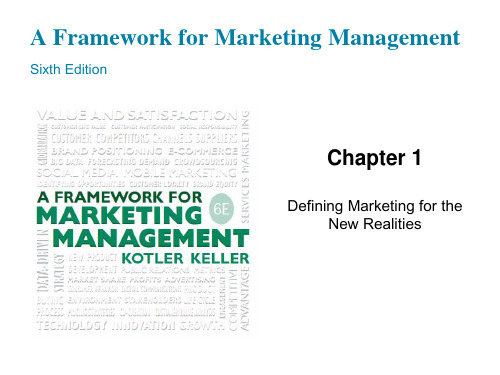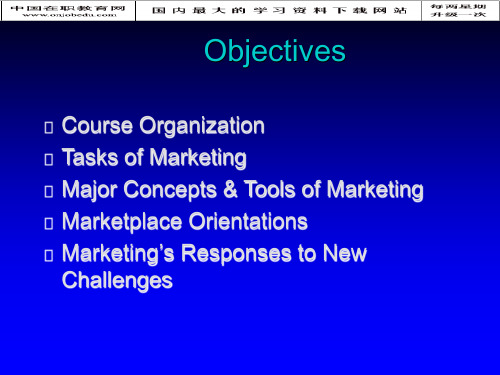marketingchannelsamanagementviewPPT(英文版)
合集下载
marketing_management-PPT

Target Marketing
Target market - a group of people that has similar wants and needs which a firm directs its marketing activities Undifferentiated approach – one marketing mix for a product to the total market Market Segmentation approach – the division of the total market into segment with marketing mix directed to different segment
PRODUCT
Product - a good, service or idea, including all attributes provided in an exchange between buyer and seller Product Classification: Consumer goods – products purchased by consumers for personal use Industrial goods – product purchased by companies to produce other products
Marketing Activities
Promotion: Determine types of promotion Design the advertising massage Selecting advertising media Schedule the advertisements Distribution: Select wholesalers and retailers Establish procedures for handling and moving products Find the best locations for plants, warehouses and retail outlets
营销管理精要英文版最新版教学课件第1章

• Consumer markets • Business markets • Global markets • Nonprofit & governmental markets
Figure 1-1 A Simple Marketing System
Core Marketing Concepts (1 of 9)
The Scope of Marketing
• Marketing is about identifying and meeting human and social needs
• AMA’s formal definition: Marketing is the activity, set of institutions, and processes for creating, communicating, delivering, and exchanging offerings that have value for customers, clients, partners, and society at large
• Earned media: word of mouth, buzz, or viral marketing
Core Marketing Concepts (6 of 9)
• Impressions: occur when consumers view a communication
• Engagement: the extent of a customer’s attention and active involvement with a communication
Who Markets?
• A marketer is someone who seeks a response-attention, a purchase, a vote, a donation-from another party, called the prospect
Figure 1-1 A Simple Marketing System
Core Marketing Concepts (1 of 9)
The Scope of Marketing
• Marketing is about identifying and meeting human and social needs
• AMA’s formal definition: Marketing is the activity, set of institutions, and processes for creating, communicating, delivering, and exchanging offerings that have value for customers, clients, partners, and society at large
• Earned media: word of mouth, buzz, or viral marketing
Core Marketing Concepts (6 of 9)
• Impressions: occur when consumers view a communication
• Engagement: the extent of a customer’s attention and active involvement with a communication
Who Markets?
• A marketer is someone who seeks a response-attention, a purchase, a vote, a donation-from another party, called the prospect
市场营销英语Unit4channelPPT课件

适用范围
适用于产品标准化程度较高,消费 者需求较为明确,且企业自身具备 足够的销售团队和渠道管理能力的 情况。
Indirect sales channel strategy
01
02
03
定义
间接销售渠道策略是指企 业通过经销商、代理商等 中间商来销售产品,从而 实现销售目标。
优点
利用中间商的渠道资源和 销售网络,快速扩大市场 份额,降低企业的销售成 本和风险。
establish a unique value proposition for the product or service and communicate this effectively to customers.
Distribution channels
select appropriate distribution channels to reach target customers and achieve sales objectives.
02
Learn different types of channels and their characteristics.
03
Master channel marketing strategies and techniques.
04
Apply channel marketing in practical scenarios.
Strategies for Marketing Channel Management
Segmentation Positioning
identify different customer groups and target them with specific marketing messages and offers.
适用于产品标准化程度较高,消费 者需求较为明确,且企业自身具备 足够的销售团队和渠道管理能力的 情况。
Indirect sales channel strategy
01
02
03
定义
间接销售渠道策略是指企 业通过经销商、代理商等 中间商来销售产品,从而 实现销售目标。
优点
利用中间商的渠道资源和 销售网络,快速扩大市场 份额,降低企业的销售成 本和风险。
establish a unique value proposition for the product or service and communicate this effectively to customers.
Distribution channels
select appropriate distribution channels to reach target customers and achieve sales objectives.
02
Learn different types of channels and their characteristics.
03
Master channel marketing strategies and techniques.
04
Apply channel marketing in practical scenarios.
Strategies for Marketing Channel Management
Segmentation Positioning
identify different customer groups and target them with specific marketing messages and offers.
市场营销学英文版最新版教学ppt课件第11章

Price Decision• Price policy must fit the retailers’– Target market and positioning– Product and service assortment– Competition– Economic factors• Retailers practice either– Everyday low pricing (EDLP)– High-low pricing
Marketing: An IntroductionThirteenth Edition
Chapter 11Retailing and Wholesaling
Learning Objectives (1 of 2)11-1. Explain the role of retailers in the distribution channel and describe the major types of retailers. 11-2. Describe the major retailer marketing decisions. 11-3. Discuss the major trends and developments in retailing.11-4. Explain the major types of wholesalers and their marketing decisions.
Major Types of Retail Organizations
Learning Objective 11-1 Summary• Retailing - selling goods or services directly to final consumers• Shopper marketing - turning shoppers into buyers• Omni-channel retailing - integrates in-store, online, and mobile shopping• Retailers classified by amount of service, product line sold, and relative prices• Corporate and contractual retail organizations
“市场营销”讲义(英文PPT 273页)

Economic Environment
Income Distribution
Subsistence economies Raw-material-exporting economies
Industrializing economies Industrial economies
Savings, Debt, & Credit Availability
Objectives
Course Organization Tasks of Marketing Major Concepts & Tools of Marketing Marketplace Orientations Marketing’s Responses to New
Challenges
Macroenvironmental Forces
World trade enablers Asian economic power Rise of trade blocs International monetary crises Use of barter & countertrade Move towards market economies “Global” lifestyles
Simple Marketing System
Communication
Industry (a collection
of sellers)
Goods/services Money
Market (a collection
of Buyers)
Information
Company Orientations Towards the Marketplace
市场营销英语Unit4channel-PPT课件

-7-
2019/3/15
Reading A
声音 翻译
» Direct channel Distributing products this way means that producers sell their goods and services directly to the consumers. There are no middlemen between the producers and consumers. The producers sell directly to their customers through door-to-door salesmen or through their own retail stores. For example, Bata India Ltd. and Liberty Shoes Ltd. have their own retail shops from where they can sell their products to their customers. Many service organizations also provide their services directly to their customers. Banks, consultancy firms, telephone companies, passenger and freight transport services are examples of where consumers receive services by a direct distribution channel.
Warming-up Activity
Warming-up Activity Task 1
营销渠道国外教材marketing channels

Marketing channels
4
• •
The link between manufacturers and customers is the channel of distribution. Channel management centers on these questions: which channel tasks will be performed by the firm and which tasks, if any, will be performed by channel members?
Marketing channels
18
3. Sales involve extensive negotiations.
4. Control of the selling job is necessary to ensure proper implementation of the total product package and to guarantee a quick response to market conditions.
Marketing channels
13
Evaluating Alternative Channels • Takes into account all the elements of the channel design process as well as important customer requirements. • Approach is to create an “ideal” channel system that fully addresses customer needs.
8
Three Primary Distributor Classifications
市场营销学第14章(英文)课件

Integrated marketing communications is the integration by the company of its communication channels to deliver a clear, consistent, and compelling message about the organization and its brands
• Broadcast • Print • Internet • Outdoor
市场营销学第14章(英文)
The Promotion Mix
Major Promotion Tools
Sales promotion is the short-term incentives to encourage the purchase or sale of a product or service
市场营销学第14章(英文)
The Promotion Mix
Major Promotion Tools
市场营销学第14章(英文)
The Promotion Mix
Major Promotion Tools
Advertising is any paid form of non-personal presentation and promotion of ideas, goods, or services by an identified sponsor
• Catalog • Telemarketing • Kiosks
市场营销学第14章(英文)
Integrated Marketing Communications
The New Marketing Communications Landscape
• Broadcast • Print • Internet • Outdoor
市场营销学第14章(英文)
The Promotion Mix
Major Promotion Tools
Sales promotion is the short-term incentives to encourage the purchase or sale of a product or service
市场营销学第14章(英文)
The Promotion Mix
Major Promotion Tools
市场营销学第14章(英文)
The Promotion Mix
Major Promotion Tools
Advertising is any paid form of non-personal presentation and promotion of ideas, goods, or services by an identified sponsor
• Catalog • Telemarketing • Kiosks
市场营销学第14章(英文)
Integrated Marketing Communications
The New Marketing Communications Landscape
营销管理,科特勒,第十二版,第一章英文PPT

1-9
Company Orientations
Production Product Selling Marketing
1-10
Marketing Mix and the Customer
Four Ps Product Price Place Promotion Four Cs Customer solution Customer cost Convenience Communication
1-4
For an exchange t occur…..There are at least two parties. Each party has something that might be of value to the other party. Each party is capable of communication and delivery. Each party is free to reject the exchange offer. Each party believes it is appropriate or desirable to deal with the other party.
1-12
I want it, I need it…..
5 Types of Needs Stated needs Real needs Unstated needs Delight needs Secret needs
1-13
Marketing Management Tasks
Developing marketing strategies Capturing marketing insights Connecting with customers Building strong brands Shaping market offerings Delivering value Communicating value Creating long-term growth
市场营销讲稿(英文版)(ppt 36页)

The aim of Marketing is to make selling superfluous. The aim is to know and understand the customer so well that the product or services fits… and sells itself. (Drucker, 1973)
l
Journals:
Journal of Marketing
Marketing News
Harvard Business Review
International Journal of Research in Marketing
Journal of Advertising 《营销导刊》 《销售与市场》 《市场营销》(人大复印资料)
•What is marketing?
Core Concepts
Needs, wants, and demands
Products
Markets
Core Marketing Concepts
Value, satisfaction, and quality Exchange, transactions, and relationships
consists of all activities that bring buyers and sellers together
Analysis, Plan, implement, control
Marketing mix(4ps)
Managing Products and Services(Product) Distributing Products and Services(Place) Pricing Products and Services(Price) Promotion Products and
l
Journals:
Journal of Marketing
Marketing News
Harvard Business Review
International Journal of Research in Marketing
Journal of Advertising 《营销导刊》 《销售与市场》 《市场营销》(人大复印资料)
•What is marketing?
Core Concepts
Needs, wants, and demands
Products
Markets
Core Marketing Concepts
Value, satisfaction, and quality Exchange, transactions, and relationships
consists of all activities that bring buyers and sellers together
Analysis, Plan, implement, control
Marketing mix(4ps)
Managing Products and Services(Product) Distributing Products and Services(Place) Pricing Products and Services(Price) Promotion Products and
市场营销讲义英文274页PPT

The Marketing Plan
Executive Summary & Table of Contents Current Marketing Situation Opportunity & Issue Analysis Objectives Marketing Strategy Action Programs Projected Profit-and-loss Controls
Opportunities
Corporate Headquarters Planning
Define the corporate mission Establish strategic business units (SBUs) Assign resources to SBUs Plan new business, downsize older businesses
Market-Oriented Strategic Planning
Objectives
Resources
Skills
Opportunities
Market-Oriented Strategic Planning
Objectives
Resources
Profit and Growth
Skills
Objectives
Define value & satisfaction - understand how to deliver them The nature of high-performance businesses How to attract & retain customers Improving customer profitability Total quality management
市场营销知识培训(英文版)(ppt 273页)

sensitive) • Offer feedback • Reduce transaction costs
2020/7/2
Customer Development
Suspects
Prospects
First-time customers
Repeat customers
Clients Advocates Partners
2020/7/2
Objectives
• Tracking & Identifying Opportunities in the Macroenvironment
• Demographic, Economic, Natural, Technological, Political, & Cultural Developments
management • Demand measurement and forecast
2020/7/2
A marketing information system (MIS) consists of people, equipment, and procedures to gather, sort, analyze, evaluate, and distribute needed, timely, and accurate information to marketing decision makers.
2020/7/2
Simple Marketing System
Communication
Industry (a collection
of sellers)
Goods/services Money
Market (a collection
2020/7/2
Customer Development
Suspects
Prospects
First-time customers
Repeat customers
Clients Advocates Partners
2020/7/2
Objectives
• Tracking & Identifying Opportunities in the Macroenvironment
• Demographic, Economic, Natural, Technological, Political, & Cultural Developments
management • Demand measurement and forecast
2020/7/2
A marketing information system (MIS) consists of people, equipment, and procedures to gather, sort, analyze, evaluate, and distribute needed, timely, and accurate information to marketing decision makers.
2020/7/2
Simple Marketing System
Communication
Industry (a collection
of sellers)
Goods/services Money
Market (a collection
marketing channels a management view PPT(英文版)

• Flow of Ownership
13 - 14
The Objective of a Supply Chain
• Maximize overall SC (Supply Chain) value created
• Supply chain value: Final Product Value – Total Supply Chain Cost SC Value = Price of Widget – Cost of all Phases in SC
How a Distributor Reduces the Number of Channel Transactions
1 4 Store 2 5
B. Number of contacts with a distributor MxC=3+3=6
3
= Manufacturer
6
= Customer
4%
21% 27%
Profit Logistics Cost Marketing Cost
• Manufacturing Cost 48%
Manufacturing Cost
13 - 5
Supply Chain Management:
The Magnitude in the Traditional View • A typical box of cereal spends 104 days from factory to sale
Marketing Channels and Supply Chain Management
Chapter 13
Objectives
• Know why companies use distribution channels and understand the functions that these channels perform. • Learn how channel members interact and how they organize to perform the work of the channel. • Know the major channel alternatives that are open to a company.
marketing channels a management view PPT(英文版)精编版

• Independent dealers relationships, dealer
are key to success
performance and full,
• Dealer network is
honest, and frequent
linked via computers communications
• Learn how channel members interact and how they organize to perform the work of the channel.
• Know the major channel alternatives that are open to a company.
13 - 11
Flows in a Supply Chain
Information Product Funds
Customer
13 - 12
Distribution Channel Functions
Transfer
Information Communication
Payments Physical Distribution
Marketing Channels and Supply Chain Management
Chapter 13
Objectives
• Know why companies use distribution channels and understand the functions that these channels perform.
13 - 15
The Objective of a Supply Chain
• Dell receives $2000 from a customer • Supply Chain Costs (information, storage,
- 1、下载文档前请自行甄别文档内容的完整性,平台不提供额外的编辑、内容补充、找答案等附加服务。
- 2、"仅部分预览"的文档,不可在线预览部分如存在完整性等问题,可反馈申请退款(可完整预览的文档不适用该条件!)。
- 3、如文档侵犯您的权益,请联系客服反馈,我们会尽快为您处理(人工客服工作时间:9:00-18:30)。
4%
21% 27%
Profit Logistics Cost Marketing Cost
• Manufacturing Cost 48%
Manufacturing Cost
13 - 5
Supply Chain Management:
The Magnitude in the Traditional View • A typical box of cereal spends 104 days from factory to sale
Negotiation
Ordering
Financing
13 - 13
Nature & Importance of Marketing Channels
Channel Members Are Connected Via A Variety of Flows
• Physical Flow • Payment Flow • Information Flow • Promotion Flow
13 - 17
How a Distributor Reduces the Number of Channel Transactions
1 2 3 4 5 6 7 8 9
= Manufacturer = Customer
13 - 18
A. Number of contacts without a distributor MxC=3X3=9
13 - 3
Production model evolution
Speed Flexibility Quality Cost
Mass Production Toyota Production System
Innovation
JIT Production System
ZeroInventory Production System
Global Logistics Production System
Artificial Production
1920
1960
1970
1980
1990
2000
13 - 4
Traditional View:
Logistics in the Manufacturing Firm
• Profit
• Logistics Cost • Marketing Cost
How a Distributor Reduces the Number of Channel Transactions
1 4 Store 2 5
B. Number of contacts with a distributor MxC=3+3=6
3
= Manufacturer
6
= Customer
Wholesaler Wholesaler
Jobber
Retailer
Consumer
3-level channel Mfg
Retailer
Consumer
13 - 20
Industrial Marketing Channels
Manufacturer
Industrial distributors
• Flow of Ownership
13 - 14
The Obze overall SC (Supply Chain) value created
• Supply chain value: Final Product Value – Total Supply Chain Cost SC Value = Price of Widget – Cost of all Phases in SC
Marketing Channels and Supply Chain Management
Chapter 13
Objectives
• Know why companies use distribution channels and understand the functions that these channels perform. • Learn how channel members interact and how they organize to perform the work of the channel. • Know the major channel alternatives that are open to a company.
Nature & Importance of Marketing Channels
• Channel choices affect other decisions in the marketing mix
Pricing, Marketing communications
• A strong distribution system can be a competitive advantage • Channel decisions involve long-term commitments to other firms
13 - 6
Definition
• Value Delivery Network
The network made up of the company, suppliers, distributors, and ultimately customers who “partner” with each other to improve the performance of the entire system.
13 - 10
Nature & Importance of Marketing Channels
• How Channel Members Add Value
Intermediaries require fewer contacts to move the product to the final purchaser. Intermediaries help match product assortment demand with supply. Intermediaries help bridge major time, place, and possession gaps that separate products from those who would use them.
13 - 1
Objectives
• Comprehend how companies select, motivate, and evaluate channel members. • Understand the nature and importance of marketing logistics and integrated supply chain management.
13 - 11
Flows in a Supply Chain
Information
Product Funds
Customer
13 - 12
Distribution Channel Functions
Information Transfer Payments Physical Distribution Risk Taking Communication
SC Value = Profit of SC
13 - 15
The Objective of a Supply Chain
• Dell receives $2000 from a customer
• Supply Chain Costs (information, storage, transportation, components, assembly, etc.)
Manufacturer’s representative
Manufacturer’s sales branch
13 - 21
Consumer
Channel Behavior and Organization
13 - 2
Case Study
Caterpillar
• Dominates world’s • Caterpillar stresses markets for heavy dealer profitability, construction and extraordinary dealer mining equipment. support, personal relationships, dealer • Independent dealers performance and full, are key to success honest, and frequent • Dealer network is communications linked via computers
= Distributor
13 - 19
Consumer Marketing Channels
0-level channel Manufacturer 1-level channel Manufacturer 2-level channel Mfg Retailer Consumer
Consumer
• Supply Chain Profit = $2000 - Supply Chain Costs • Supply Chain Profit is shared across all stages in SC • Supply Chain Success is measured by total supply chain profitability, not profits at an individual stage
